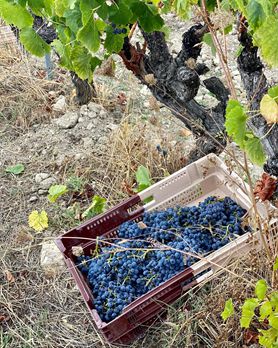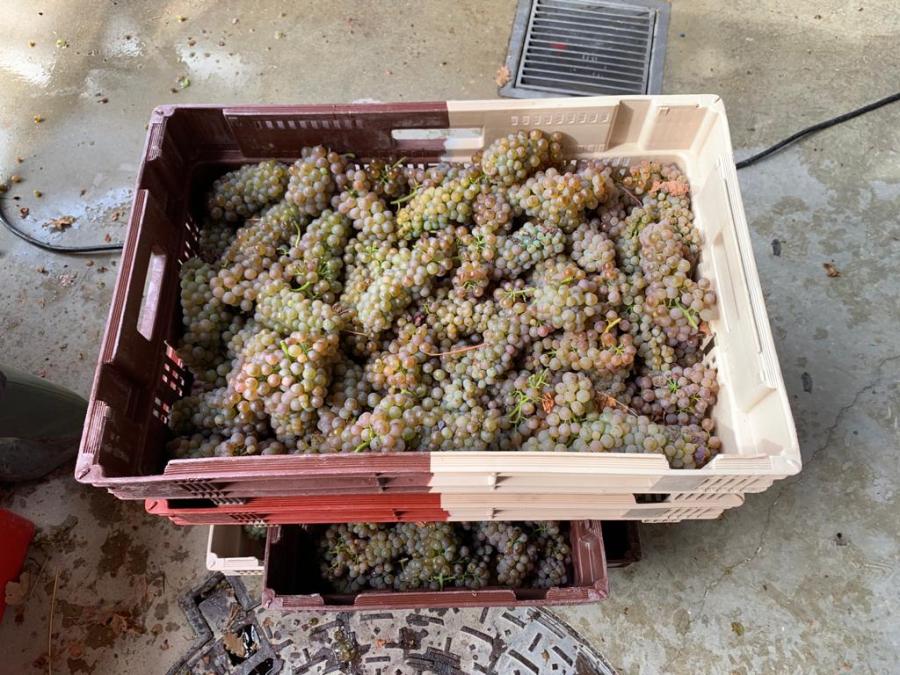SUMMARY: Lots of Extreme Weather caused lots of losses
A spring drought, a huge storm on June 6th with cane-snapping high winds, a bone-dry summer, huge storms at harvest. One of the most roller-coaster years to date. Combined with Covid-related staffing and operational challenges, we’ll be happy to see the hide of 2020 in the vineyard as well. Yields were down 30% but in the end the juice was concentrated and good (especially the Syrah), not dissimilar from 2019 stylistically.
GROWING SEASON: Big storm and lots of cane damage to the whites
After a very, very dry start to the season, on June 6th, nature hit us hard.
The thirsty vines gorged themselves on the rainfall. Apart from a bit of hail, once the high winds picked up, the canes and canopy, unusually heavy with water, were torn or, in some places, completely broken off.
Our whites, on the other side of the hill suffered the most – in particular, our Rolle (Vermentino) and Roussanne, which was badly battered. As a result, we took the decision not to produce our top white wine Aliot this year.
The winds also hit our Grenache at flowering, resulting in wide-spread coulure… Apart from (negatively) impacting yields, this may prove to work to our advantage long-term, since Grenache can produce compact, heavy bunches, and its berries are thin-skinned, making it very susceptible to botrytis if we encounter any rain at harvest (as we did this year). The looser bunches did indeed allow some air to circulate more freely and kept everything healthy.
Thankfully, the storm’s damage wasn’t extensive, and it occurred early in the season.
Fewer vineyard treatments and very dry summer: great for disease control
Apart from the storm, only 8mm of rain in total graced the vineyard from June to September. The overall season was dry and disease pressure was so low that we managed to skip not one, but two, vineyard treatments, finishing up in July, a month earlier than usual, with a total copper sulphate spray rate of 2.5kg/ ha, well under the permitted 4kg/ha for Organics and 3kg/ha for Biodynamics, let along conventional farming..



HARVEST – STRESSFUL BUT SHORT
Starting a week or two earlier than usual, on the 17th of September, and spanning only a short two-week period instead of 3-4, this was one of our speediest vintages, finishing on the 1st October.
That said, it certainly wasn’t short on drama….
Yields way down
Our yields are always low relative to the neighbouring valley due to our old vines, extreme growing conditions and cultivation techniques favouring quality over quantity. But this year they were down to an average of 20hl/ ha, with our Grenache at a low 22hl/ha. The whites at 15 hl/ha, and the Syrah at a measly 12hl/ha!
Covid Constraints
The ongoing Covid-19 health crisis complicated the organisation, reshaped to ensure everyone’s safety. Harvesters were more spaced out than usual (giving the impression that each row progressed more slowly), every team member received their own named backpack with daily snacks, water, and a mug for coffee, so none of those convivial “pauses café”. Later, they were given an individual, multi-course lunch box for the all-important dejeuner, so that we could at least all eat together outside, shouting conversations from across the courtyard, which helped to improve the morale.
Then came the Rain
Well, 2020 will certainly go down as the muddiest vintage in recent memory. Three hours after starting the harvest, it decided to rain. Three days later, it rained another 40mm just as we were turning our attention to the more clay-predominant terroirs—someone has a sense of humor.
At one point our weather sources were even predicting a week of solid rain which, thankfully, never came to fruition. Winegrower wisdom and good sense dictate that one should never head out into the vineyard immediately following rainfall, especially for picking, to avoid the since picking grapes when wet raises pH and can impact concentration, particularly with heavy vehicles. But with so many possible rainstorms in the works, we decided to pick anyway, rushing out on the days when the rain had subsided since the wind was helping to dry out the canopy. In the end, this was the right call: our ripe Grenache or Mourvèdre can take a few rain showers, but after three or four downpours and several days of humidity, botrytis (and friends) would have appeared and we would have almost certainly lost the crop.
Seb, our terrifically talented tractor driver, is the only person I’ve ever seen reversing up rocky terrain among vineyard rows, with a full trailer on the back at top speeds. On one particularly boggy day, we managed a triple-whammy of getting the truck, vineyard car and even the tractor completely stuck in the mud.
IN THE CELLAR – CONCENTRATION AND SOME BEAUTIFUL SYRAH
Some Gorgeous Grenache
We were bracing ourselves for some extremely long sorting sessions at the winery, but thanks to the careful sorting already carried out by our amazingly stoic harvesters, yields were way down but bunches came into the cellar in remarkably healthy condition. Despite the drizzle, the Grenache for the Rosé was really good-looking, to the point where we debated over whether to use them for a cracking Le Rosé, or to make more of our reds, earlier in the picking calendar. Rosé it was!
Thankfully, we managed to bring in everything the day before the headline-hitting Storm Alex struck. The team had to pull through some very big days to get the grapes in before then. We were very pleased to be looking at the deluge from inside, during our socially distanced, end-of-harvest dinner, with a healthy glass of wine in hand.
Silky, concentrated Syrah
As fermentation monitoring and extraction on the reds continued, the concentration of the vintage became apparent, especially on the silky, olive-liquorice of our Syrah (eventually destined for Héloïse). This had already proven itself to have an exceptionally high total anthocyanin content; the lab took the time to tell us so, too.
For the whites and Rosé, the colours also came in arrestingly ‘dark’ at first, but adjusted themselves during the following weeks with some very careful cellar work and blending. Fermentations/MLF were blissfully unproblematic as there were no tanks to ‘keep an eye on’ this year. However, an unseasonably cold spell in mid-October did somewhat slow down the end of alcoholic fermentation for our Viognier (already in barrique) as well as a few barrique of the Rosé that hadn’t yet finished; this came from the tank which we decided not to inoculate).


REGION
With our harvests starting as late as they do due to our altitude (<500m above sea level), we always flirt with the beginning of the winter storm season, but this year it seems that the storm season budged up by about a full month, presenting a unique challenge. Talking to fellow vigneron/ne, there was a big division among us in 2020 between those that picked much earlier than they would have liked to avoid the start of the rainfall, many of whom were finishing as we were starting. There were those that waited for peak maturity; it will likely be a fairly heterogeneous vintage for the region, but with some real gems to be found.
We’re very fortunate to have strong foundations as we adapt to an ever-changing climate right now, not only in terms of Climate Change, but practically in any way one can think. Old vines, a close-knit family and empathetic team, and the family support network went a long way this year to ensure that we pulled out the stops and managed to make some lemonade from the climactic lemons.

